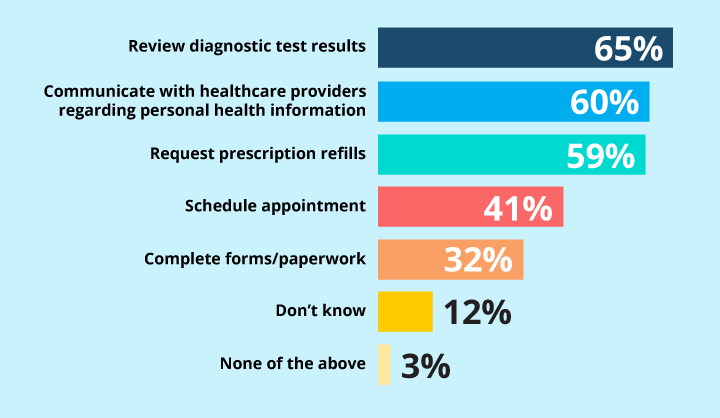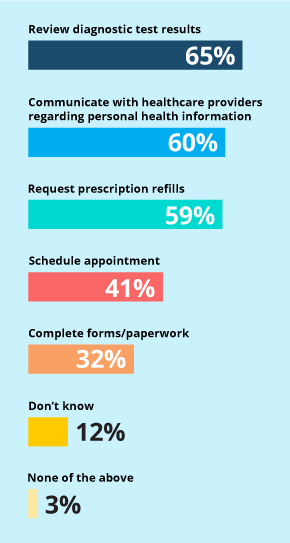Patient portals are commonly described as websites that give users access to their personal health information such as discharge summaries, lab results, and e-prescriptions — all pulled from the provider’s EHR.
In addition to this basic functionality, many portals allow patients to securely message their doctors, schedule visits, apply for prescription refills, pay medical bills, or even upload health information on their own. Here’s the rundown of the most popular function of patient web portals according to Medscape Practice Workflow Report 2017:
Source: Medscape Practice Workflow Report 2017
With the advent of value-based care, patient portals have shown an upsurge of adoption across all medical specialties. Still, there’s a lot of scepticism and confusion attached to the technology. Many providers are still on the fence about introducing a patient portal, while others seek to replace the one they have, and are disappointed in.
In this article, we’ll examine the promises and pitfalls of patient portals and try to determine the primary factors that should guide providers in their decision to invest in one.
Main Benefits
Despite the name, patient portals do not solely focus on helping laymen view information relating to their health. In fact, the benefits these solutions deliver to the public are tightly interwoven with the advantages that become available to providers.
Patients: Convenient Service
Time- and effort-saving consumer applications in such fields as finance and commerce are fueling people’s expectations of all services. Healthcare rose up to the challenge by moving scheduling, prescription medication renewals, bills payment, and similar operations online — as handy tabs within a patient portal.
Providers: Improved Efficiency
The introduction of a patient portal into the clinical workflow helps providers automate a large number of tasks that are otherwise performed manually, such as answering patients’ questions, getting feedback, scheduling visits, and sharing billing info.
If the portal allows users to add personal health information, the provider can use special tools to keep all such data organized and searchable. What this does is broaden the doctor’s view of a patient’s health in progress, improving the chances of adverse trends being spotted and interfered with sooner.
More than that, integrating patient-generated data into EHR and PHM systems for analysis translates into more detailed insights and accurate predictions about the state of the practice.
Patients: Better Communication
The ability to reach a doctor for advice between visits is one of the most popular features of patient portals. Be it secure emailing, in-app chat, or video consults, reliable communication tools are key to making a patient feel safe and appreciated.
Instant access to health records makes it possible for patients to share data with medical professionals beyond their usual setting — for instance, on a holiday or a business trip.
Providers: Financial Incentives
Patient portals are a prerequisite of patient-centered care — a strategy that impacts consumer satisfaction, and, by extension, the provider’s revenue. In that same vein, patient satisfaction surveys like HCAHPS are increasingly being tied to reimbursement rates from payers.
Last but not least, patient portals make it way easier to market medications, supplements, preventive tests, and other products or services to the public.
Patients: Health Information Availability
The full extent of the doctor’s comments during a visit can be overwhelming and difficult to memorize right there and then. All too often, patients realize they’ve been nodding along without making proper notes and are reluctant to ask for clarification.
Patient portals provide swift access to the doctor’s recommendations, making it easy to double-check if the patient is adhering to the treatment plan and dosage correctly. In addition, rehashing the content of previous visits helps the doctor and the patient to be on the same page and encourages shared decision-making.
Providers: Stronger Patient Engagement
Every doctor would prefer to have patients with a high level of health literacy and self-discipline. Unfortunately, the reality is quite different.
With patient portals, providers get a convenient way to reach patients with educational information and remind them to stay on track with the proposed care plan. This is especially effective in chronic care where significant changes of diet and lifestyle are required for the treatment to take effect.
More involvement from patients consistently translates into better health outcomes. And, at the end of the day, this is the core purpose of good healthcare.
New Liabilities
For all the advantages listed above, patient portals bring a fair share of legal, financial, and data security risks with them.
Chink in the Armor
Electronic health information is a coveted prize for hackers and identity thieves. From their point of view, a patient portal is another link that can be exploited in data breaches and ransomware attacks.
Often, it’s patients themselves who neglect basic data security measures and put their data and the whole system in danger. Thus, the provider should assume not only the responsibility to protect PHI (HIMSS suggests measures like multilayer authentication, data encryption, and data backup), but to educate all users on applicable security policies.
The Question of Uptake
The cost of developing and integrating a full-blown patient portal can dampen the enthusiasm of shareholders. The investment will only pay off when followed by a steep uptake and regular usage.
Uneven access to technology, old age, security concerns — any combination of these factors can turn a patient against a newly minted patient portal. It is up to the provider, then, to devise a clever and ubiquitous marketing strategy that will help the solution take off.
Your Own Patient Portal: To Build or Not To Build?
The short answer is: do it. The longer answer goes like this: do it once you are fully aware of your priorities and prepared to deal with new responsibilities.
A smart way to go about this is to identify your budget constraints, interoperability needs, and patient preferences before running it by a trustworthy HIT vendor. The combination of tech skills and domain experience can give your team a real leg up, especially in case of limited in-house tech resources.
Over the years, Oxagile has accumulated considerable expertise in healthcare IT, including telehealth systems, EMR/EHR, population health management technology, and more. We provide a full range of services, from consulting to custom software development to software customization. You can drop us a line to see how we can help your practice.






















